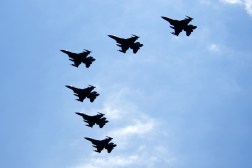2022 in review: DOD and Congress take aim at improving operations in the information environment

The Department of Defense and the armed services published various strategies, plans and doctrine in 2022 for operating in the information environment. Congress, too, has continued its pursuit to push the DOD to improve in this area, seemingly concerned it is not moving fast enough to beat back adversaries.
Information has become a more prominent aspect in modern military ops. Adversaries have sought to exploit the information environment on a daily basis short of actual conflict, in what many experts refer to as the “gray zone.”
As such, the Defense Department has sought to play catch up as many aspects of its information warfare prowess atrophied after the Cold War and during the 20-plus years of counterinsurgency operations against technologically inferior and less resourced enemies.
At the top level, the Joint Staff published a revision to its information doctrine, Joint Publication 3-04, Information in Joint Operations, which wasn’t publicly released. However, DefenseScoop learned that the document builds upon previous doctrine while introducing new concepts.
The National Defense Strategy, released in October, also takes stock of information ops, recognizing their importance in the strategic environment.
“Deterrence depends in part on competitors’ understanding of U.S. intent and capabilities. The Department must seek to avoid unknowingly driving competition to aggression. To strengthen deterrence while managing escalation risks, the Department will enhance its ability to operate in the information domain — for example, by working to ensure that messages are conveyed effectively. We will work in collaboration with other U.S. Federal departments and agencies along with Allies and partners,” the document said in a section about the role of information in deterrence.
The strategy also notes that tailored information ops can be used to support — and maybe even lead — the DOD’s response to adversaries’ coercion attempts.
Additionally, the Pentagon is still working on an update to its 2016 strategy for operations in the information environment as well as working to designate a joint force trainer and a joint force provider for information operations, much how U.S. Cyber Command is the joint force trainer and provider for cyber.
All these elements are mandated in the fiscal 2020 National Defense Authorization Act — and DOD is working to meet them.
“In the short term, we have made significant progress on two tasks: conducting an informational operational posture review and updating the strategy for operations in the information environment,” Maj. Gen. Matthew Easley, deputy principal information operations advisor, said at a conference hosted by NDIA in November. “The capabilities, gaps and strategies outlined in these two documents will be critical to ensuring the joint force can dominate [in the] information environment.”
Officials expect to publish the forthcoming strategy in early 2023, according to Easley.
When it comes to the services, the Marine Corps enshrined operations in the information environment into doctrine with the June publication of Marine Corps Doctrinal Publication-8, Information. That document aims to describe the purpose and mechanics of using information as a warfighting tool for the entire service — highlighting the new strategic context that Marines and the rest of the joint force find themselves in.
For its part, the Air Force published its blueprint earlier this year for how it will compete in this realm. The Operations in the Information Environment Strategic Plan identifies key activities and milestones to transform how the Air Force operates in this space to achieve a vision where information is foundational to all military activities. However, the document wasn’t publicly released.
The Army, meanwhile, plans to release its updated doctrine for information advantage in late 2023.
Within the Navy, a top official highlighted the high demand for information warfare personnel in the fleet.
“The competition is so keen now that my warfighting peers are approaching me and in a good way want me to do my job. They want to invest in actually having information warfare experts as part of their team because the environment is so complex now,” Vice Adm. Kelly Aeschbach, commander of Naval Information Forces, said in October.
However, despite the raft of new strategies and progress the Defense Department has apparently made, some in Congress are not satisfied with the pace of change.
The fiscal 2023 NDAA, which was signed into law last week, included several provisions that seek to limit funds if the DOD does not meet Congress’ requests.
The first provision will limit funds for travel for personnel in the Office of the Secretary of Defense if the Pentagon does not submit joint lexicon for terms related to information operations as required by the fiscal 2020 policy bill.
Each of the services has organized slightly differently around and has varying definitions for information warfare, which encompasses some level of cyber, electronic warfare, intelligence and/or information ops. While they were charged to come up with a common lexicon, that hasn’t been done yet. An aide from the House Armed Services Committee told reporters earlier this year that the threat to restrict funding was intended to provide a “nudge” to the department.
A second provision restricts funding until the DOD submits its information operations strategy and posture review — including the designation of joint force providers and joint force trainers.
A third provision requires a briefing to Congress on how the Pentagon plans to deter and counter adversaries in the information environment.






